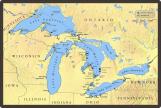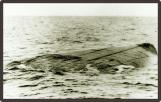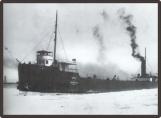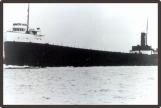1
Great Storm of 1913 ShipwrecksNovember 1913
 Credits:
Credits:Wikipedia User: brian0918 (http://en.wikipedia.org/wiki/user:brian0918)
U.S. Geological Survey
3
Charles S. Price upside down near Port Huron, MINovember 1913
Lake Huron
 Credits:
Credits:Historical Collection of the Great Lakes, Bowling Green State University, Bowling Green, Ohio, U.S.A.
4
The Charles S. Price was built in 1910 by American Shipbuilding Company in Lorain, Ohio and owned by Mahoning Steamship Company. She was the sister ship of the Isaac M. Scott. The Charles S. Price was 504 feet long with a beam of 54 feet. Her net tonnage was 4, 901 and her gross tonnage was 6, 322.In the days following the Great Storm, the Charles S. Price became known as the "Mystery Ship" because she was found floating upside down near Port Huron, Michigan and was not immediately identified. When she sank, the Charles S. Price took all 28 of her crew with her.
It was once believed that the Charles S. Price had collided with the Regina, another boat that foundered in the Great Storm of 1913, since bodies washed ashore wearing life preservers from the Regina and were later identifed as sailors from the Charles S. Price. When the Price's hull was examined while she was upside down on the lake before finally sinking, it showed no evidence of a collision.
6
The Isaac M. Scott was built in 1909 by the American Shipbuilding Company. She was 504 feet long with a beam of 54 feet. Her net tonnage was 4, 840 and her gross tonnage was 6, 372. The Isaac M. Scott was the sister ship of the Charles S. Price. She was sighted on November 9 on Lake Huron and was in great difficulty due to the severity of the storm. During the storm, the Isaac M. Scott capsized and sank, taking all 28 crew with her. Unlike the other vessels lost in the Great Storm, not a single body from the Isaac M. Scott was ever recovered.In 1976, the Isaac M. Scott was discovered, seven miles from Thunder Bay Island at the bottom of Lake Huron.
7
WexfordEarly 20th Century
 Credits:
Credits:"Shipwrecks of the Great Lakes" (Book), Paul Hancock, PRC Publishing Ltd, London
Huron County Museum, Goderich, Ontario, Canada
8
Wexford in drydockEarly 20th century
Collingwood, Ontario, Canada
 Credits:
Credits:Huron County Museum, Goderich, Ontario, Canada
9
The Wexford was built in 1883 in Sunderland, England by William Doxford and Sons Company. Originally an ocean-going vessel, the Wexford was purchased by the Western Steampship Company and changes were made that were necessary for her to sail on the Great Lakes. The Wexford was 250 feet long and had a net tonnage of 1,204; her gross tonnage was 2, 104. On November 9th, 1913 the vessel was headed up Lake Huron when she encountered the storm at its worst. She needed to seek shelter and some believe she may have tried to get into the Goderich harbour; some witnesses questioned during the Great Storm of 1913 inquest say they heard her distress whistle on November 9th. The Wexford was unable to enter the harbour due to the very heavy gale and a very narrow passage between the breakwaters. It is believed at this point the Captain headed back out into Lake Huron. The Wexford sank soon after this, taking all 18 crew with her.On August 25th, 2000, the wreck of the Wexford was discovered north of Grand Bend.
10
Artistic Rendering of Wexford2000
 Credits:
Credits:Bob McGreevy, Great Lakes Marine Artist - © Bob McGreevy 2000
11
The Wexford was officially discovered on August 25, 2000. Don Chalmers suspected he had found her with a fish finder on August 15, 2000 but a dive could not be done until August 25; this was when the shape he had seen was confirmed to be that of the wreck of the Wexford. The Wexford lies upright in 75 feet of water just off St. Joseph's, Ontario.12
ArgusEarly 20th Century
 Credits:
Credits:"Shipwrecks of the Great Lakes" (Book), Paul Hancock, PRC Publishing Ltd, London
Huron County Museum, Goderich, Ontario, Canada
13
The Argus was built in 1905 by the American Shipbuilding Company in Lorain, Ohio and owned by the Interlake Steampship Company of Cleveland, Ohio. Originally, her name was the Lewis Woodruff and she was renamed the Argus in 1913. She was the fleetmate of the Hydrus. The Argus was 416 feet long with a beam of 50 feet. Her net tonnage was 3, 380 and her gross tonnage was 4, 707.On November 8, 1913 the Argus passed by Detriot, Michigan, heading north. The next day, she was sighted off Goderich and is said to have been struggling to stay afloat in the ferocious conditions of the storm. She was sighted by the steamer George C. Crawford and soon after this, she quickly disappeared under the waves and took all 24 crew members with her.
The wreck of the Argus was found at the bottom of Lake Huron in 1972 near Kincardine, Ontario.
14
HydrusEarly 20th Century
 Credits:
Credits:"Shipwrecks of the Great Lakes" (Book), Paul Hancock, PRC Publishing Ltd, London
Huron County Museum, Goderich, Ontario, Canada

